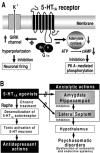Therapeutic role of 5-HT1A receptors in the treatment of schizophrenia and Parkinson's disease
- PMID: 21091640
- PMCID: PMC6493836
- DOI: 10.1111/j.1755-5949.2010.00211.x
Therapeutic role of 5-HT1A receptors in the treatment of schizophrenia and Parkinson's disease
Abstract
5-HT(1A) receptors have long been implicated in the pathogenesis and treatment of anxiety and depressive disorders. Recently, several lines of studies have revealed new insights into the therapeutic role of 5-HT(1A) receptors in treating schizophrenia and Parkinson's disease. Specifically, 5-HT(1A) receptors seem to be a promising target for alleviating antipsychotic-induced extrapyramidal side effects (EPS) and cognitive/affective disorders in schizophrenia. In the treatment of patients with Parkinson's disease, 5-HT(1A) agonists are expected to improve not only affective symptoms (e.g., anxiety and depression), but also the core parkinsonian symptoms as well as antiparkinsonian agents-induced side effects (e.g., L-DOPA-induced dyskinesia). Here, the therapeutic mechanisms mediated by 5-HT(1A) receptors in schizophrenia and Parkinson's disease are reviewed. This evidence should encourage discovery of new 5-HT(1A) ligands, which can resolve the unmet clinical needs in the current therapy.
© 2010 Blackwell Publishing Ltd.
Conflict of interest statement
The author has no conflict of interest with any commercial or other associations in connection with the submitted article.
Figures




References
-
- Roth BL. Multiple serotonin receptors: Clinical and experimental aspects. Ann Clin Psychiatry 1994;6:67–78. - PubMed
-
- Baumgarten HG, Grozdanovic Z. Psychopharmacology of central serotonergic systems. Pharmacopsychiatry 1995;28:73–79. - PubMed
-
- Feighner JP, Boyer WF. Serotonin‐1A anxiolytics: An overview. Psychopathology 1989;22(Suppl 1):21–26. - PubMed
-
- Fuller RW. Role of serotonin in therapy of depression and related disorders. J Clin Psychiatry 1991;152(Suppl l):52–57. - PubMed
-
- Ohno Y. Tandospirone citrate, a new serotonergic anxiolytic agent: A potential use in Parkinson's disease In: Mizuno Y, Fisher A, Hanin I, editors. Mapping the progress of Alzheimer's and Parkinson's Disease. New York : Kluwer Academic/Plenum, 2002;423–428.
Publication types
MeSH terms
Substances
LinkOut - more resources
Full Text Sources
Other Literature Sources
Medical

